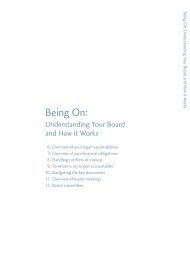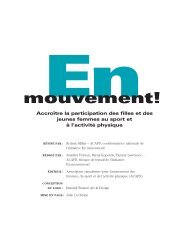Do Transitioned Athletes Compete at an Advantage or Disadvantage
Do Transitioned Athletes Compete at an Advantage or Disadvantage
Do Transitioned Athletes Compete at an Advantage or Disadvantage
You also want an ePaper? Increase the reach of your titles
YUMPU automatically turns print PDFs into web optimized ePapers that Google loves.
<strong>Tr<strong>an</strong>sitioned</strong> <strong>Athletes</strong> <strong>an</strong>d Competition 3<br />
1.0 Abstract<br />
<strong>Tr<strong>an</strong>sitioned</strong> <strong>at</strong>hletes present a unique challenge to sp<strong>or</strong>t governing bodies with respect to<br />
determining the eligibility of such <strong>at</strong>hletes to compete against physically b<strong>or</strong>n men <strong>an</strong>d women.<br />
The IOC Stockholm consensus on sex reassignment in sp<strong>or</strong>ts allows tr<strong>an</strong>sitioned men <strong>an</strong>d<br />
women to compete against members of their new sex provided th<strong>at</strong> sex reassignment surgery is<br />
complete, the individuals are legally recognized as a member of their new sex <strong>an</strong>d proper crosssex<br />
h<strong>or</strong>mone administr<strong>at</strong>ion has been ongoing f<strong>or</strong> <strong>at</strong> least two years. The basis behind this<br />
st<strong>at</strong>ement is to minimize the effects of previous sex h<strong>or</strong>mone exposure on <strong>at</strong>hletic perf<strong>or</strong>m<strong>an</strong>ce.<br />
The purpose of the current review is to examine the scientific evidence th<strong>at</strong> exists to determine if<br />
tr<strong>an</strong>sitioned <strong>at</strong>hletes compete <strong>at</strong> <strong>an</strong> adv<strong>an</strong>tage <strong>or</strong> disadv<strong>an</strong>tage as compared with physically b<strong>or</strong>n<br />
men <strong>an</strong>d women. Men outperf<strong>or</strong>m women in <strong>at</strong>hletic events by approxim<strong>at</strong>ely 11-18%,<br />
potentially as a result of well known sex differences including th<strong>at</strong> men are taller, have a gre<strong>at</strong>er<br />
maximal aerobic <strong>an</strong>d <strong>an</strong>aerobic capacity, muscle mass <strong>an</strong>d strength <strong>an</strong>d altered substr<strong>at</strong>e<br />
utiliz<strong>at</strong>ion characteristics. The observed sex differences are the result of differences in<br />
testosterone <strong>an</strong>d estrogen. Testosterone increases muscle mass <strong>an</strong>d strength, bone size <strong>an</strong>d<br />
mineral content <strong>an</strong>d haemoglobin content. Estrogen has a profound effect on substr<strong>at</strong>e<br />
metabolism during exercise, increasing the reli<strong>an</strong>ce on lipid st<strong>or</strong>es. As both testosterone <strong>an</strong>d<br />
estrogen c<strong>an</strong> influence perf<strong>or</strong>m<strong>an</strong>ce measures it is imp<strong>or</strong>t<strong>an</strong>t to ensure th<strong>at</strong> tr<strong>an</strong>sitioned <strong>at</strong>hletes<br />
have sex h<strong>or</strong>mone levels within the n<strong>or</strong>mal physiological r<strong>an</strong>ge f<strong>or</strong> their new sex. While<br />
h<strong>or</strong>mone concentr<strong>at</strong>ions in tr<strong>an</strong>sitioned women fall in line with those of physically b<strong>or</strong>n women,<br />
tr<strong>an</strong>sitioned men spend the maj<strong>or</strong>ity of time with supraphysiological levels of testosterone <strong>an</strong>d<br />
higher estrogen as compared with physically b<strong>or</strong>n men. Cross-sex h<strong>or</strong>mone administr<strong>at</strong>ion to<br />
tr<strong>an</strong>sitioned individuals results in haemoglobin <strong>an</strong>d subcut<strong>an</strong>eous f<strong>at</strong> content <strong>an</strong>d muscle crosssectional<br />
areas similar to those values in physically b<strong>or</strong>n men <strong>an</strong>d women. To d<strong>at</strong>e, no study has<br />
examined the effects of cross-sex h<strong>or</strong>mones on <strong>an</strong>y objective measures of <strong>at</strong>hletic perf<strong>or</strong>m<strong>an</strong>ce<br />
(maximal aerobic capacity, time trials). Additionally, no trial has been conducted in tr<strong>an</strong>sitioned<br />
<strong>at</strong>hletes as compared with physically b<strong>or</strong>n men <strong>an</strong>d women <strong>at</strong>hletes. As such, there is no concrete<br />
evidence to supp<strong>or</strong>t <strong>or</strong> refute the position th<strong>at</strong> tr<strong>an</strong>sitioned <strong>at</strong>hletes compete <strong>at</strong> <strong>an</strong> adv<strong>an</strong>tage <strong>or</strong><br />
disadv<strong>an</strong>tage as compared with physically b<strong>or</strong>n men <strong>an</strong>d women <strong>at</strong>hletes.






